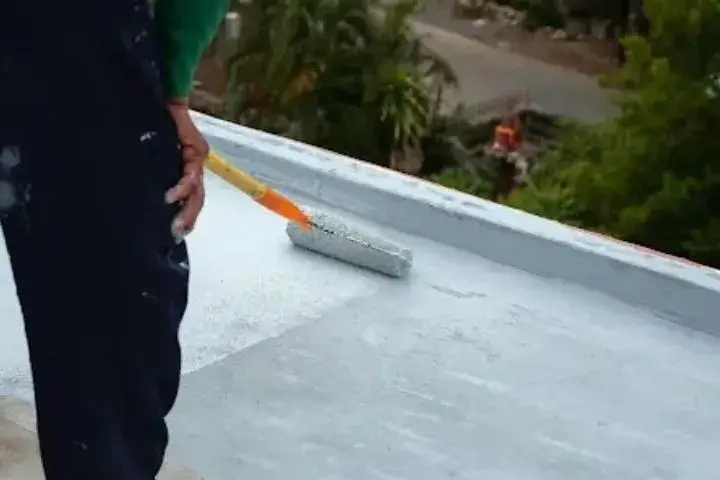Your roof is your home’s first line of defence against rain and moisture. Without proper waterproofing, even a brand-new roof can quickly develop leaks, leading to costly repairs, mould growth, and structural damage.
Waterproofing of roofs is the process of applying a protective layer to prevent water from seeping into your home. It ensures long-term durability, safeguarding your roof, walls, and interior from water-related issues. Investing in waterproofing from the start helps avoid cracks, seepage, and dampness, preserving the integrity of your structure.
Want to know how to effectively waterproof your new roof? Keep reading to learn the 6 key steps, benefits, and the best waterproofing products for a leak-free and long-lasting roof!
Contents
6 Steps of Roof Waterproofing
Step 1: Inspection, Surface Preparation, and Cleaning
The first step to waterproof on roofs is to thoroughly inspect and treat the roof for any damage, such as cracks, honeycombs, etc. All such defects should be repaired with crack fillers. Construction joints should be identified and grouted. Expansion joints should be properly filled and covered with a mechanical joint sealing system or any other suitable means.
Proper surface preparation, repair, and treatment are extremely critical to ensure the success of a roof waterproofing job. The roof surface must also be cleaned of debris, dirt, and moss to ensure good adhesion for the waterproofing materials. The surface should also be free of standing water and dry.
Step 2: Flashing and Drainage
It is significant to pay extreme attention to some common entry points to the leaks such as chimneys, vents, and skylights. Proper flashing should be installed around these areas to direct water away from the roof.
Additionally, the direction of the slope, gutters, and downspouts should be checked to ensure that they are functioning properly to drain water off the roof without any problem.
Step 3: Primer Application
Depending on the chosen waterproofing material, a primer might be applied to the clean and dry roof surface. This helps improve adhesion and prepare the surface for the waterproofing membrane. Allow the primer to cure as per the manufacturer’s recommendation.
Step 4: Waterproofing Membrane Installation
The chosen waterproofing membrane is then installed according to the manufacturer’s instructions. This can involve rolling out pre-fabricated sheets, applying liquid coatings, etc. Different materials might require specific tools and techniques.
Step 5: Inspection, Testing, and Protection
After the waterproofing materials have cured completely, a final inspection is done to check the installation and ensure that there are no gaps or inconsistencies. It is advisable to hydro-test the roof to confirm water tightness. Finally, it is recommended to install a protective layer (tiles, IPS, etc) over the fully tested installed waterproof membrane to prevent mechanical damage.
Step 6: Maintenance
Regular maintenance is crucial for the longevity of your waterproofing of the roof. This includes periodic inspections for any damage or wear, keeping gutters and downspouts clean, and removing debris from the roof surface.
Top Waterproofing Materials for Roofs
There are numerous materials used in new roof waterproofing. However, the best waterproofing chemical for terraces depends on several factors such as roof type, climate, budget, durability, etc. When considering roof waterproofing details, the following are a few required materials.
Liquid Waterproofing Membranes
These form seamless barriers, and are one of the best waterproofing for concrete roofs and complex roof shapes. Polyurethane waterproofing membranes offer exceptional elasticity and UV resistance for large roofs, podiums, and water-retaining structures. Acrylic liquid membranes are high elongation yet cost-effective options for smaller roofs and wet areas.
Pre-formed Sheet Membranes
Preformed membranes are waterproof chemicals for roofs made from synthetic polymers. They come in various thicknesses and can be installed on both flat and sloping roofs. Unlike traditional asphalt-based membranes, they don’t require torch application and often come with heat-welded seams or self-adhesive seams for enhanced watertightness.
Metal Roof Coatings
These are used on metal roofs to protect against rust and corrosion while offering waterproofing. Different types cater to specific needs and durability requirements.
Benefits of Waterproofing Your New Roof
- Prevents Water Damage: The primary benefit of having your terrace waterproofed is to ensure a roof leakage solution. This helps in avoiding issues like ceiling leaks, dampness, and corrosion damage to the structure
- Reduces Maintenance Costs: Waterproofing the roof can significantly reduce the need for frequent repairs and maintenance.
- Improves Energy Efficiency: Waterproofing materials often reflect sunlight and heat, helping to keep buildings cooler in hot weather. This can reduce the need for air conditioning, leading to lower energy bills and improved energy efficiency.
- Structural Protection: Water infiltration can weaken the structural integrity of a building over time. Waterproofing solutions on roofs protect the overall structure from potential damage caused by water penetration.
- Enhances Aesthetic Appeal: A waterproofed roof can maintain its appearance longer, as it is less prone to the growth of algae, fungi, and other organisms that can cause discolouration and deterioration.
Sunanda Global’s Products for New Roof Waterproofing
Why Choose Sunanda Global for Your Roof Waterproofing?
Sunanda Global is the best waterproofing company in India, dedicated to revolutionizing the construction industry. We are committed to offering the best waterproofing solutions with consistent quality. We are highly invested in our Research and Development efforts to innovate and introduce advanced waterproofing products and methods. Our team of experts constantly explores new technologies and materials to improve the effectiveness and longevity of our waterproofing solutions.
If you’re looking for reliable waterproofing contractors in Mumbai or anywhere else, we’re here to help. Whether it’s a residential project, commercial building, or large infrastructure, our dedicated team is ready to assist you at every step, from initial consultation to final application.
Connect with us for your waterproofing needs and experience unparalleled service that sets the standard in the industry.



Pingback: 5 Steps for Basement Waterproofing